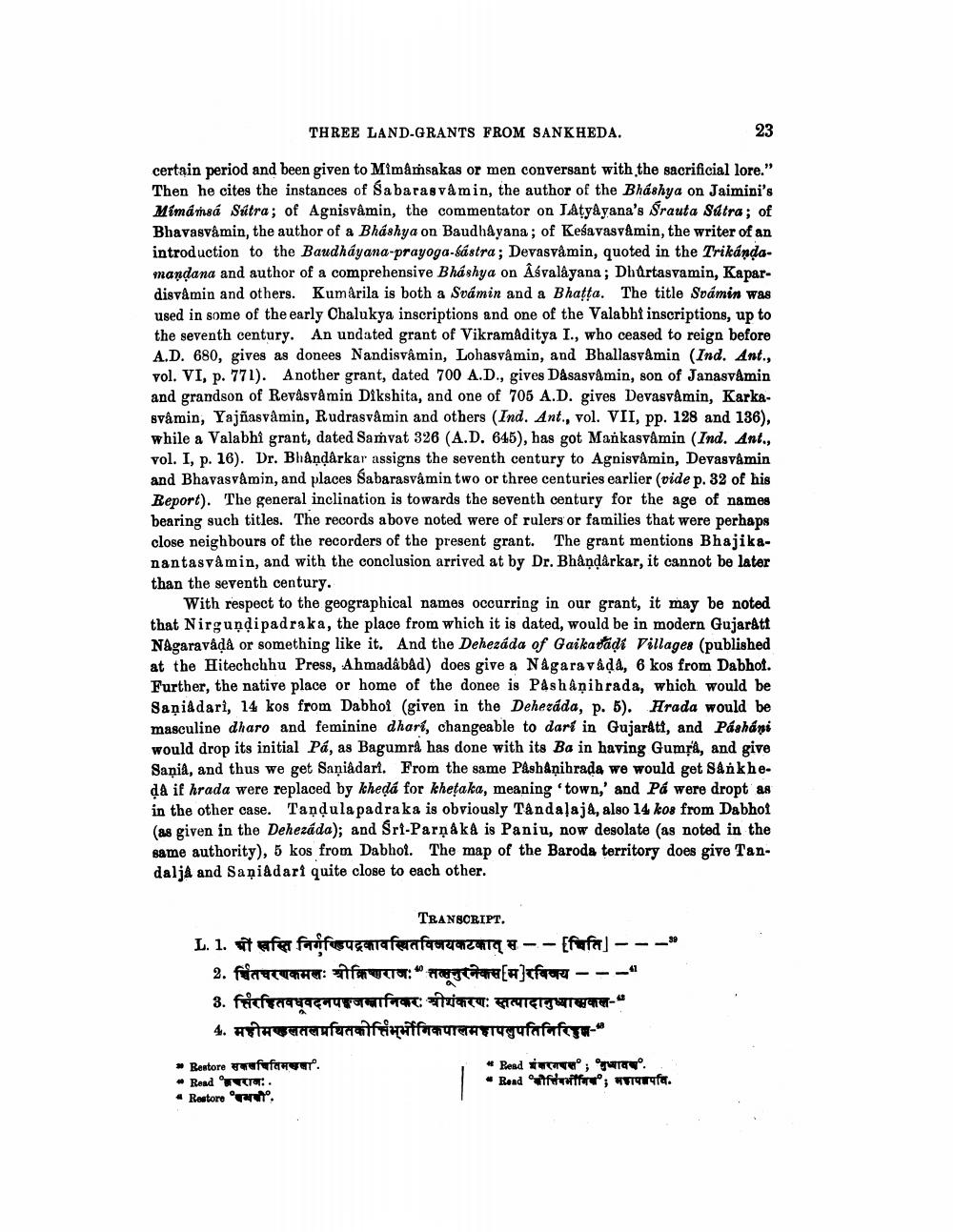________________
THREE LAND-GRANTS FROM SANKHEDA.
certain period and been given to Mimâmsakas or men conversant with the sacrificial lore." Then he cites the instances of Sabarag våmin, the author of the Bhashya on Jaimini's Mímánsá Sútra; of Agnisvåmin, the commentator on Jatyayana's Srauta Sutra; of Bhavagvåmin, the author of a Bhashya on Baudhayana; of Keśavasvamin, the writer of an introduction to the Baudhayana-prayoga-sástra; Devasvåmin, quoted in the Trikándamandana and author of a comprehensive Bhashya on Asvalayana; Dhartasvamin, Kapardisvâmin and others. Kumarila is both a Svámin and a Bhatta. The title Svámin was used in some of the early Chalukya inscriptions and one of the Valabhi inscriptions, up to the seventh century. An updated grant of Vikramaditya I., who ceased to reign before A.D. 680, gives as donees Nandisvâmin, Lohas våmin, and Bhallasvamin (Ind. Ant., vol. VI, p. 771). Another grant, dated 700 A.D., gives Dasasvamin, son of Janasvamin and grandson of Revåsvåmin Dikshita, and one of 705 A.D. gives Devasvamin, Karkasvåmin, Yajñasvamin, Rudras våmin and others (Ind. Ant., vol. VII, pp. 128 and 136), while a Valabhi grant, dated Samvat 326 (A.D. 645), has got Mankasvamin (Ind. Ant.. vol. I, p. 16). Dr. Bhåndarkar assigns the seventh century to Agnisvåmin, Devasvåmin and Bhavasvamin, and places Sabarasvåmin two or three centuries earlier (vide p. 32 of his Report). The general inclination is towards the seventh century for the age of names bearing such titles. The records above noted were of rulers or families that were perhaps close neighbours of the recorders of the present grant. The grant mentions Bhajikanantasvamin, and with the conclusion arrived at by Dr. Bhandarkar, it cannot be later than the seventh century.
With respect to the geographical names occurring in our grant, it may be noted that Nirgundipadraka, the place from which it is dated, would be in modern Gujarati Någaravådd or something like it. And the Dehezáda of Gaikatadt Villages (published at the Hitechchhu Press, Ahmadabad) does give a Nagara vada, 6 kos from Dabhof. Further, the native place or home of the donee is P&shanih rada, which would be Saniddari, 14 kos from Dabhoi (given in the Deherdda, p. 5). Hrada would be masculine dharo and feminine dhart, changeable to dari in Gujarati, and Pásháni would drop its initial Pá, as Bagumra has done with its Ba in having Gumra, and give Saņia, and thus we get Saņiadari. From the same Påshåņibrada we would get Sankheda if hrada were replaced by kheda for khetaka, meaning 'town,' and Pá were dropt as in the other case. Taņdula padraka is obviously Tandalaja, also 14 kos from Dabhof (as given in the Dehezáda); and Sri-Parņaka is Paniu, now desolate (as noted in the same authority), 5 kos from Dabhol. The map of the Baroda territory does give Tan. dalja and Saņiadari quite close to each other.
TRANSCRIPT. L. 1. it afer fadfcugarafanfarer42AT7 # -- [fufar] --- 2. ffaecuma: itfam ucrar:* Prote[n]tfarper ---" 3. freferencana
<T: PureTW -* 4. महीमहलतलप्रथितकीर्तिर्भोगिकपालमहापलुपतिनिरिहुल
• Restore सकसमितिमा
Read r. • Restore 'radi.
* Read • Read
Teo; . finiftra; 799fa.




